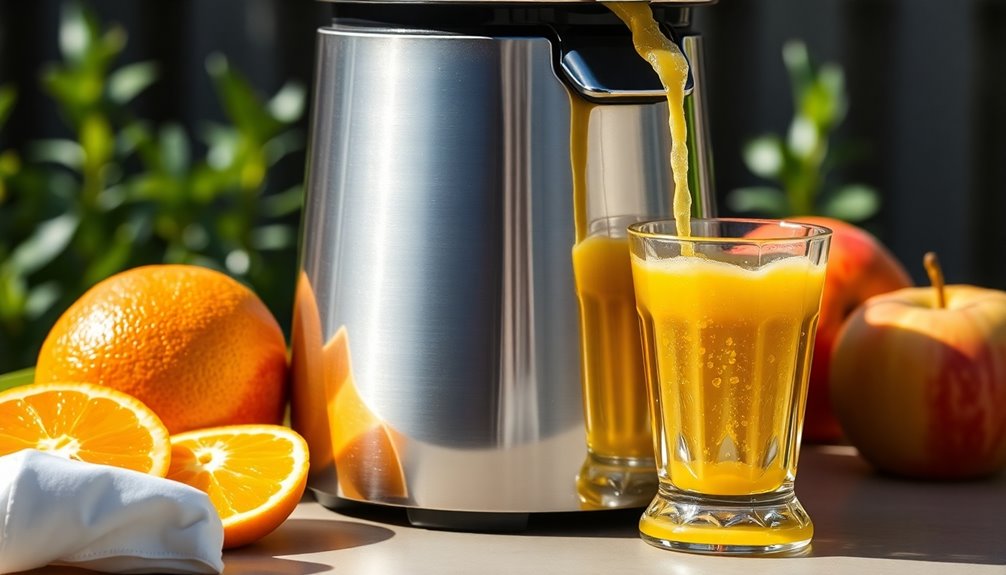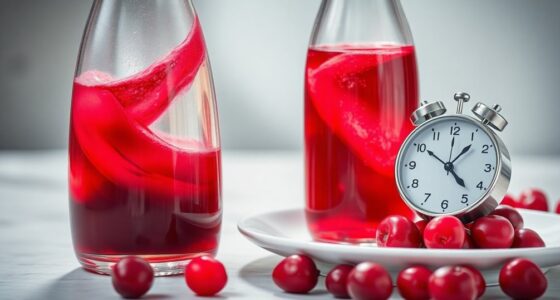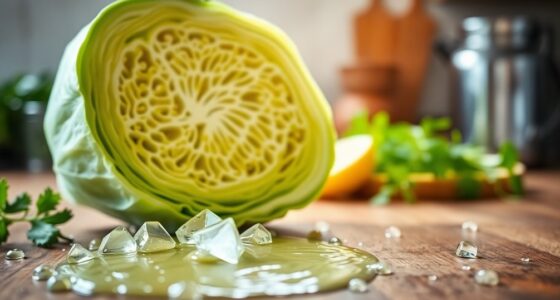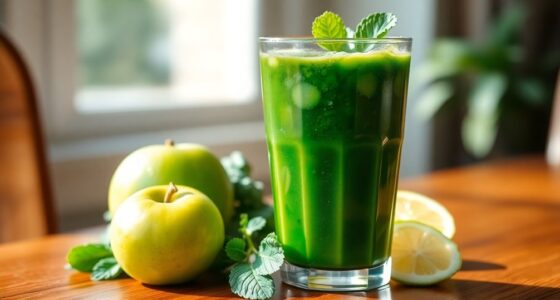To make juice, you start with cleaning and sorting the fruit, removing any dirt or damaged pieces. Next, you peel the fruit to improve taste before extracting the juice using methods like belt presses or centrifuges. After extraction, the juice is filtered for clarity and pasteurized for safety. Finally, it's packaged in sterilized containers to maintain freshness. This process ensures a delicious and safe product, and there's much more to discover about each step involved.
Key Takeaways
- Juice production begins with meticulous cleaning and sorting of fruit to ensure high quality and flavor.
- The fruit is then peeled to remove bitter compounds, enhancing the juice's taste.
- Various extraction methods, such as belt presses and centrifuges, are utilized to efficiently obtain juice.
- Filtration removes solids for clarity, while pasteurization heats the juice to ensure safety and eliminate harmful bacteria.
- Lastly, the juice is packaged in sterilized containers and rapidly cooled for freshness before distribution.
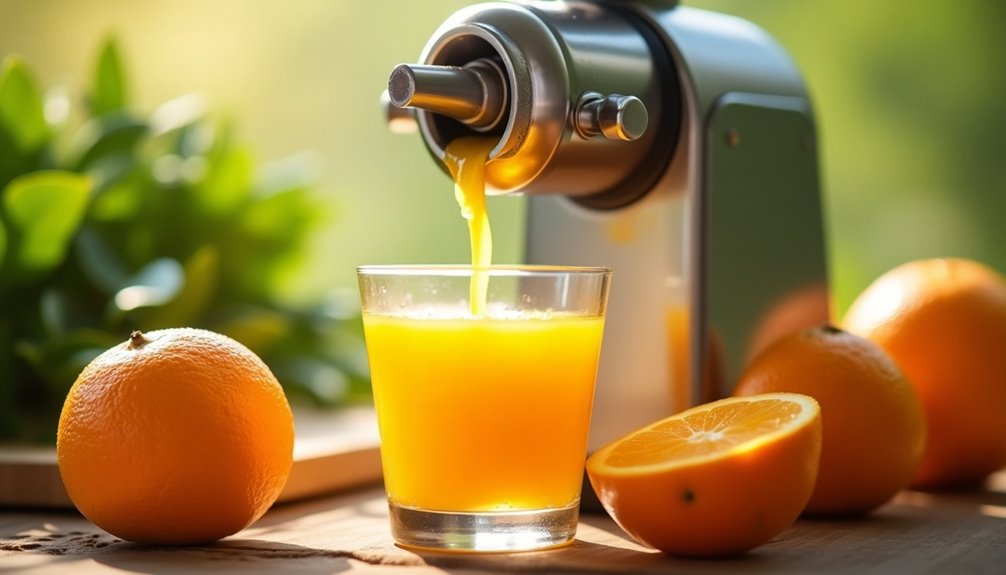
Juice production starts with a meticulous cleaning and sorting process, where workers remove dirt and damaged fruit to ensure only the best quality makes it to extraction. This initial step is crucial, as it sets the foundation for the entire juice processing journey. You want to begin with high-quality raw fruit, as this directly impacts the flavor and nutritional value of the final product.
After the fruit washing, the next step involves peeling the fruit to eliminate any bitter compounds that could negatively affect the taste of your juice.
Once the fruit is prepped, it's time for juice extraction. Various methods come into play here, depending on the type of fruit and desired consistency. Belt presses and centrifuges are commonly used to efficiently extract juice while preserving the integrity of the fruit. This stage is where the magic happens, as fresh juice begins to flow, capturing all the vibrant flavors and nutrients locked inside the fruit.
After extraction, the juice undergoes filtration. This process removes any suspended solids, enhancing both the clarity and taste of the juice. You'll appreciate the difference when you pour a glass of juice that looks inviting and tastes refreshing. Filtration is essential not just for aesthetics but also for ensuring that the juice is smooth and enjoyable to drink.
Next up is pasteurization, a critical step in ensuring consumer safety. This process involves heating the juice to a specific temperature for a set amount of time, effectively eliminating harmful bacteria that could compromise your health. This is where strict regulatory standards come into play, ensuring that the juice isn't only delicious but also safe for you and your family to enjoy. You can trust that no additives or preservatives are included in the juice, as these practices are tightly regulated to promote consumer safety and product integrity.
Once the juice has been pasteurized, it's filled into sterilized containers. This is another layer of protection for your juice, as it helps maintain its freshness and flavor. Rapid cooling follows the filling process, which preserves the juice's quality, ensuring that what you taste on your table is as close to fresh as possible.
Finally, the juice is ready for distribution. Each step, from fruit sorting to the final filling, is designed to create a product you can trust. You get to enjoy a refreshing glass of juice, knowing it's been carefully crafted with your safety and satisfaction in mind. Additionally, it is important to source high-quality fruits as this directly affects the overall quality of the juice.
Frequently Asked Questions
What Is the Process of Making Juice?
When you make juice, you start by cleaning and sorting the fruit to ensure it's fresh and high-quality.
Next, you peel the fruit and use extractors to get the juice out efficiently.
After that, you filter the juice to remove any solids, improving its look and shelf life.
You then pasteurize the juice to kill harmful bacteria.
Finally, you pack it into sterilized containers and cool it quickly to lock in flavor.
How Is 100% Fruit Juice Made?
To make 100% fruit juice, you start with ripe fruits, washing them thoroughly to remove any impurities.
Then, you extract the juice using large presses or specialized machines.
After extraction, you filter the juice for clarity and taste before pasteurizing it by heating it to kill harmful bacteria while keeping nutrients intact.
Finally, you fill the juice into sterilized containers quickly to preserve flavor and cool it to maintain quality. Once the containers are sealed, it’s essential to store them in a cool, dark place to prevent any degradation of the juice’s fresh taste. Regular taste tests allow us to monitor how genius juice is performing over time, ensuring that each batch meets our high standards. Additionally, feedback from customers helps us refine our process, enabling us to deliver a consistently delightful product.
Why Is Electricity Referred to as Juice?
Did you know that over 90% of people use the term "juice" to refer to electricity in casual conversation?
This slang captures the essence of energy, likening it to the invigorating effect of fruit juice. Just like juice provides essential nutrients, electricity powers our devices, giving them life.
The analogy emphasizes energy's importance and liveliness, making it relatable in everyday discussions about battery life, power levels, and the flow of electrical current.
How Is OJ Made?
When you think about how orange juice is made, picture the journey from tree to table.
First, you harvest ripe oranges and wash them thoroughly. Next, you inspect each fruit, discarding any that aren't perfect.
After peeling, you juice the oranges using large presses, extracting sweet liquid while leaving behind bitter peels.
Finally, you pasteurize the juice to ensure safety, cool it quickly, and package it for distribution.
Enjoy that fresh taste!
Conclusion
Now that you've journeyed through the vibrant world of juice-making, you can appreciate the magic behind every sip. From the sun-kissed fruits to the whirl of the juicer, each step sings a sweet melody of flavor and freshness. So, next time you pour yourself a glass, remember the dance of nature and craftsmanship that brought those flavors to life. Enjoy the symphony of taste, and let the juice awaken your senses like a burst of sunshine on a summer morning!
Cindy thoroughly researches juicing trends, techniques, and recipes to provide readers with practical advice and inspiration. Her writing style is accessible, engaging, and designed to make complex concepts easy to understand. Cindy’s dedication to promoting the advantages of juicing shines through her work, empowering readers to make positive changes in their lives through the simple act of juicing.

